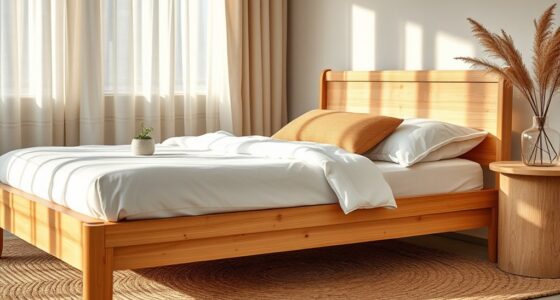To improve your sleep environment, add indoor plants like snake plants, peace lilies, and aloe vera which naturally filter toxins, boost humidity, and create a calming atmosphere. These plants help purify the air, reduce allergens, and support better breathing at night. Placing them near your bed can promote restful sleep and a healthier space. Keep exploring to discover more tips on choosing and caring for these plants to maximize their benefits.
Key Takeaways
- Indoor plants like Peace Lily, Snake Plant, and Rubber Plant effectively remove toxins such as formaldehyde and benzene, improving air quality for better sleep.
- Plants increase indoor humidity, reducing respiratory issues and creating a more comfortable, relaxing sleep environment.
- Proper placement away from drafts and vents ensures plants maximize air purification without stress or damage.
- Low-maintenance options like Aloe Vera and Snake Plant are ideal for bedroom settings, promoting clean air with minimal care.
- Incorporating plants as decor enhances tranquility, reduces stress, and fosters a restful atmosphere conducive to quality sleep.
Snake Plant: A Low-Maintenance Air Purifier
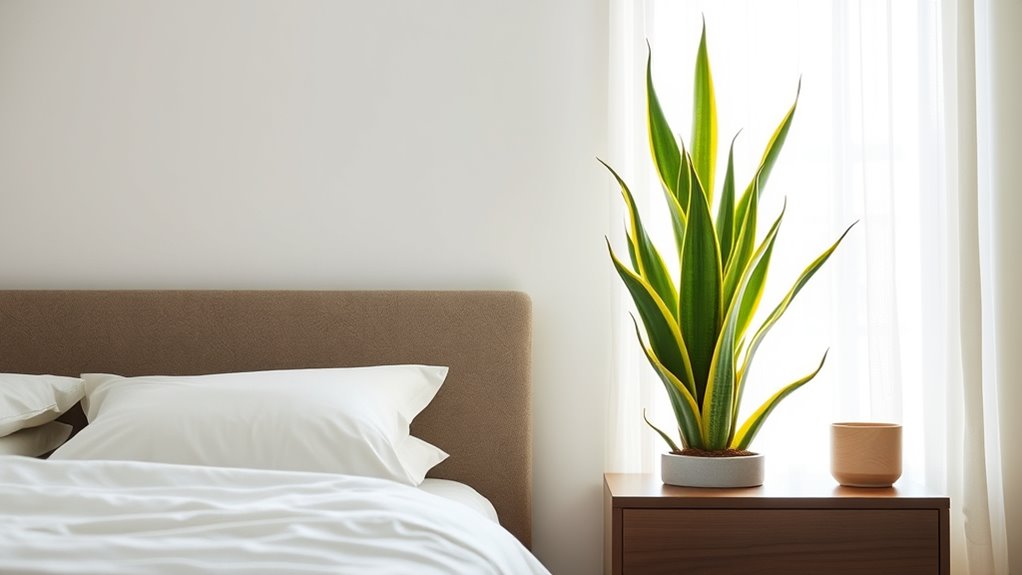
If you’re looking for an easy-care plant that also improves your bedroom air quality, the snake plant is an excellent choice. Its watering schedule is simple—you only need to water it every couple of weeks, allowing the soil to dry out completely between waterings. Overwatering can cause root rot, so it’s best to err on the side of dryness. When potting, use well-draining soil and a pot with drainage holes to prevent excess moisture from sitting around the roots. You don’t need to fuss much with the snake plant; it thrives in low light and requires minimal attention. Proper potting techniques ensure healthy growth, making it a perfect low-maintenance addition to your bedroom. This plant not only looks sleek but also actively filters indoor air pollutants. Using well-maintained pots and proper filter replacement can enhance its air-purifying benefits over time.
Peace Lily: Enhancing Humidity and Purifying Air
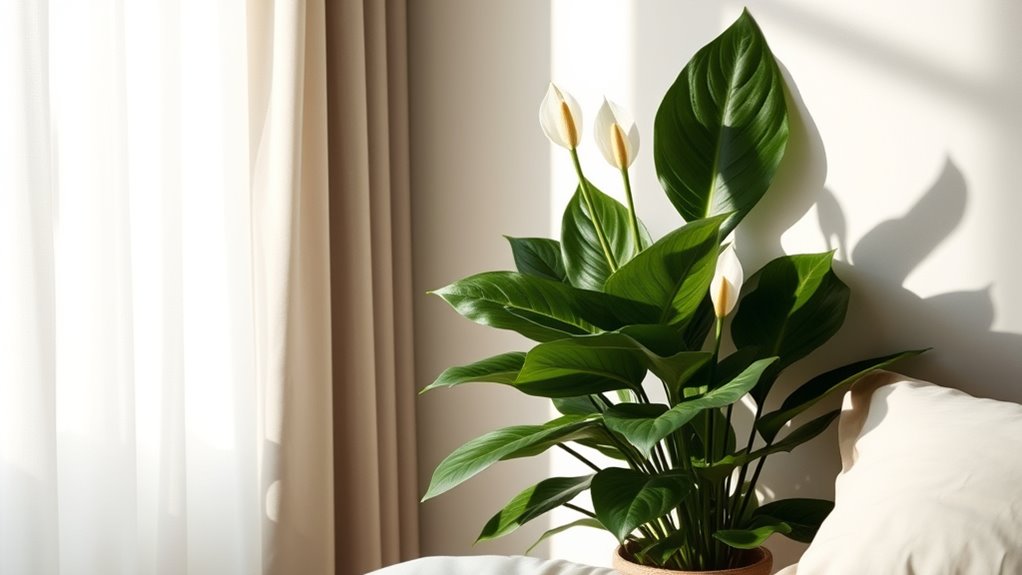
A peace lily not only adds beauty to your bedroom but also naturally boosts humidity levels. It actively filters the air, removing toxins and improving your indoor environment. Plus, it’s easy to care for, making it a perfect choice for maintaining a healthier, more comfortable space. Incorporating air purifiers with HEPA filters can further enhance the air quality and support your well-being.
Humidity Boosts Naturally
The peace lily naturally boosts humidity in your bedroom by releasing moisture through its leaves, creating a more comfortable environment. This process provides humidity benefits that help prevent dry skin, sore throats, and respiratory issues. By adding natural moisture to the air, the peace lily supports better sleep quality and overall well-being. Its ability to increase humidity makes it an excellent choice for bedrooms with dry air, especially during winter months when heating systems reduce moisture levels. You’ll notice a more balanced and soothing atmosphere, which can ease breathing and promote relaxation. Regularly caring for your peace lily guarantees it continues to provide these humidity benefits, making your bedroom a healthier, more comfortable space. Additionally, its air purifying properties can help remove toxins from the air, further enhancing your sleep environment.
Air Purification Power
Peace lilies actively improve your bedroom air quality by removing common indoor pollutants like formaldehyde, benzene, and trichloroethylene. Their leaves absorb toxins, breaking them down into harmless substances, which enhances air purity. To keep your peace lily functioning most effectively, proper plant watering is essential—avoid overwatering to prevent root rot. Ensuring good soil drainage helps the plant absorb nutrients effectively and prevents water from stagnating. A well-draining soil mix allows excess water to escape, maintaining healthy roots and consistent purification. As the plant filters the air, it also releases moisture, which boosts humidity levels naturally. This dual action of purifying air and increasing humidity makes the peace lily a powerful addition to your bedroom environment, improving sleep quality and overall air freshness. Additionally, providing the right amount of light, such as indirect sunlight, supports the plant’s health and its growth cycle, ensuring it continues to purify and humidify your space effectively.
Easy Care Requirements
Because peace lilies are known for their adaptability, they’re among the easiest houseplants to care for. They thrive with moderate water requirements—water them when the top inch of soil feels dry, but avoid overwatering to prevent root rot. These plants prefer bright, indirect sunlight but can tolerate low light conditions, making them perfect for bedrooms. Direct sunlight may scorch their leaves, so keep them away from harsh rays. Peace lilies also appreciate higher humidity, which helps them enhance air quality and sleep. If your air feels dry, mist the leaves occasionally or place a humidifier nearby. Additionally, the air-purifying properties of peace lilies contribute to a healthier indoor environment. Overall, this plant’s low-maintenance needs and versatility make it an ideal choice for creating a healthier, more comfortable bedroom environment.
Aloe Vera: Natural Air Filter and Skin Care Ally
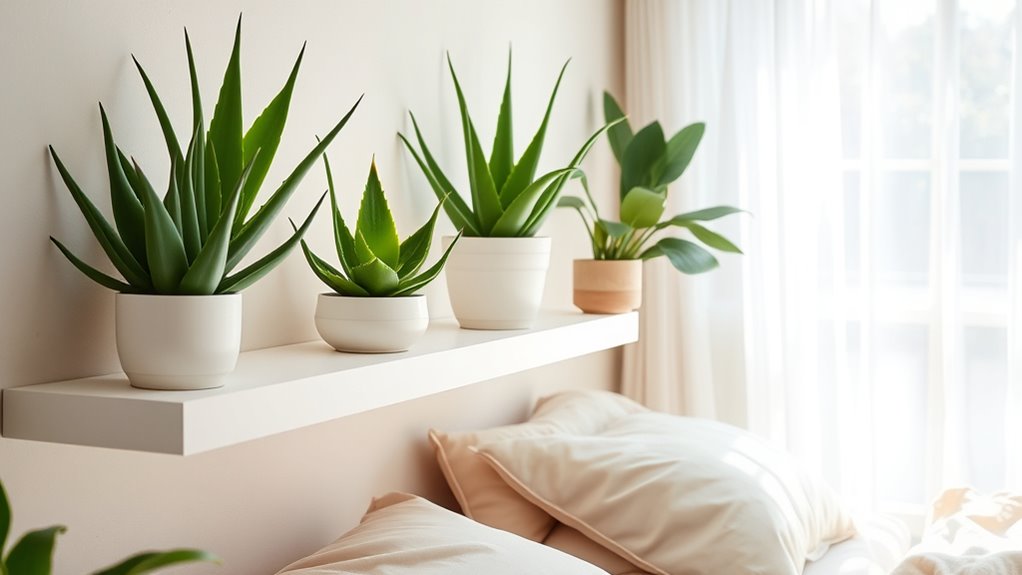
If you’re looking for a versatile plant to improve your living space, Aloe Vera is an excellent choice. Not only does it act as a natural air filter, but it also offers skin care benefits. You can easily propagate new plants through leaf cuttings or offsets, making it a cost-effective addition. Make sure it’s planted in well-draining soil with minimal watering—Aloe Vera prefers dry conditions. Its low-maintenance nature makes it perfect for bedrooms. Place it where it can get bright, indirect sunlight for ideal growth. The table below highlights key care tips:
| Aspect | Details |
|---|---|
| Propagation | Leaf cuttings or offsets |
| Soil requirements | Well-draining, sandy or cactus mix |
| Light exposure | Bright, indirect sunlight |
Additionally, understanding AI integration in devices can help you optimize plant care through smart technology.
Areca Palm: Humidifier and Stress Reducer
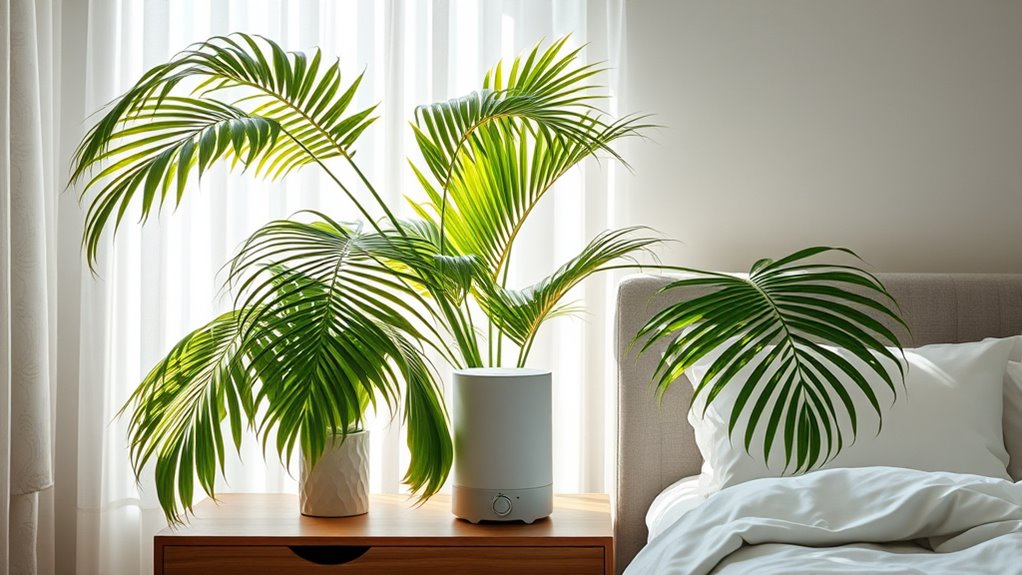
The Areca Palm is an excellent addition to your bedroom since it naturally increases humidity and helps reduce stress. Its lush fronds create a calming environment, making it easier to unwind. When choosing decorative pots, opt for styles that complement your bedroom decor, such as sleek ceramics or woven baskets, to enhance its visual appeal. Proper indoor plant placement is key; position the Areca Palm near a window with indirect light, ensuring it receives adequate sunlight without direct exposure. This placement helps it thrive while maximizing its humidifying benefits. Additionally, studies show that positive thinking can improve overall mental health and resilience, making the presence of calming plants even more beneficial. Not only does the Areca Palm improve air quality, but its presence also promotes relaxation, making your bedroom a more peaceful retreat. Its natural stress-reducing qualities make it a must-have for better sleep.
Rubber Plant: Effective Toxin Removal for Better Sleep

The Rubber Plant is known for its ability to absorb toxins from the air, making your bedroom healthier. By improving air purity, it creates a space that encourages restful sleep. With this plant, you can breathe easier and wake up feeling more refreshed.
Toxin Absorption Capabilities
Rubber plants are known for their impressive ability to absorb indoor toxins, making them a valuable addition to your bedroom. They excel at toxin absorption, actively removing harmful chemicals like formaldehyde and VOCs from the air. This natural air purification boosts sleep quality by creating a cleaner environment. To see how they compare with other plants, check out this quick overview:
| Plant Name | Toxin Absorption Capabilities | Best for |
|---|---|---|
| Rubber Plant | Removes formaldehyde, VOCs | Bedroom air quality |
| Snake Plant | Absorbs benzene, xylene | Low-light spaces |
| Peace Lily | Cleans ammonia, mold spores | Humid environments |
Adding a rubber plant helps your indoor air stay fresh, supporting better sleep every night. Indoor air quality can be significantly improved by incorporating these plants into your bedroom environment.
Enhancing Air Purity
Because rubber plants are highly effective at absorbing indoor toxins, they considerably enhance air purity in your bedroom. To maximize their toxin-removing benefits, consider lighting effects; bright, indirect sunlight encourages healthy growth and toxin absorption. Avoid placing the plant in low-light corners, which can hinder its cleansing ability. Instead, position it near a window with filtered light or in a well-lit corner. Proper plant placement ensures ideal air filtration and keeps the rubber plant thriving. Keep the plant away from heating vents or drafts, as temperature fluctuations can stress it and reduce its effectiveness. Regularly wipe the leaves to remove dust, allowing better air exchange. Additionally, choosing the right indoor plants can further improve air quality and sleep quality. With thoughtful lighting effects and strategic placement, your rubber plant will effectively purify your air, creating a healthier sleeping environment.
Promoting Restful Sleep
Since toxins in the air can disrupt your sleep, placing a rubber plant in your bedroom can help create a more restful environment. Its ability to effectively remove airborne toxins promotes nighttime relaxation, making it easier to fall asleep and stay asleep. Incorporating a rubber plant into your bedroom decor not only enhances visual appeal but also supports better sleep quality. Additionally, understanding trust issues in relationships emphasizes the importance of a trustworthy environment, which can also contribute to your overall sense of peace and restfulness. To maximize its benefits, consider: – Positioning the plant near your bed for ideal air purification – Using it as a natural focal point in your bedroom decor – Combining it with calming colors and soft lighting for a serene atmosphere – Ensuring proper care to keep the plant healthy and effective A healthy rubber plant helps you breathe easier, fostering a peaceful sleep environment.
English Ivy: Reducing Allergens and Improving Air Quality
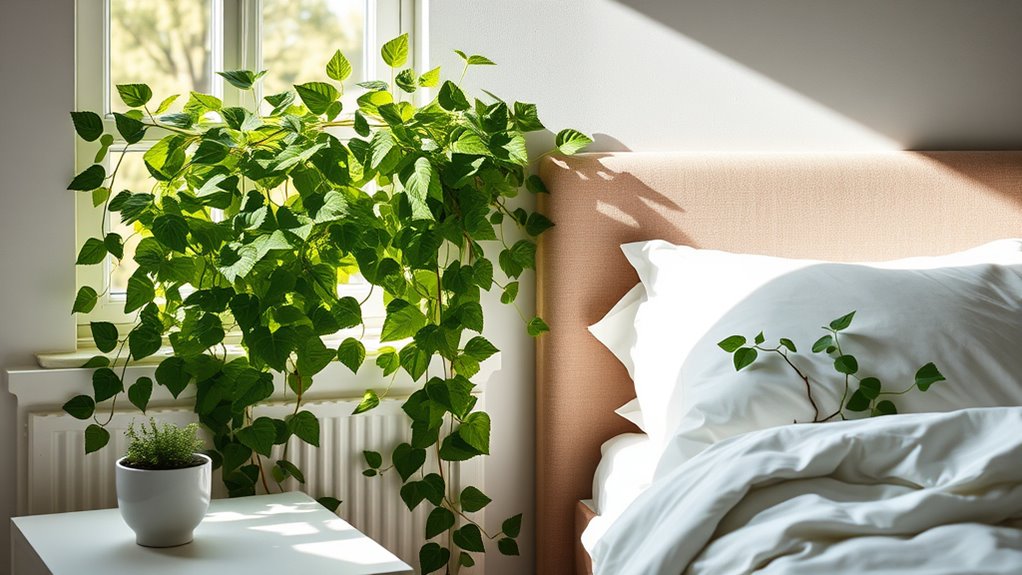
English Ivy is an effective plant for reducing allergens and improving air quality in your bedroom. Its leaf variegation adds visual interest while actively filtering pollutants like mold, bacteria, and airborne toxins. The plant’s vigorous root system helps absorb these contaminants efficiently, contributing to cleaner air. English Ivy also helps reduce airborne allergens that can trigger respiratory issues, making your sleep environment healthier. Its trailing growth makes it a versatile choice for shelves or hanging baskets, allowing you to position it where it can best purify the air. Regularly maintaining its root system guarantees the plant stays healthy and effective. Understanding toilet flushing mechanisms can help in managing household water use and costs, supporting a more sustainable environment. By adding English Ivy to your space, you support better air quality and create a more allergen-free, restful environment.
Frequently Asked Questions
Which Bedroom Plants Are Safest for Pets and Children?
When choosing pet safe plants and child friendly greenery for your bedroom, you prioritize safety first. Look for non-toxic options like spider plants, areca palms, or Boston ferns, which are known to be pet safe plants. These plants add beauty without risking your pets or children’s health. Always verify specific plant safety, and keep plants out of reach to prevent accidental ingestion. Prioritizing pet safe plants guarantees a healthy, worry-free environment for everyone.
How Often Should I Water These Air-Purifying Plants?
Think of your plants as silent guardians, quietly thriving with proper care. You should follow a consistent watering schedule, typically once a week, but adapt based on your plant’s needs and environment. Keep an eye on the soil — if it feels dry, it’s time to water. Regular plant maintenance ensures they stay healthy and vibrant, helping them purify your air and enhance your sleep naturally.
Can These Plants Thrive in Low-Light Bedroom Conditions?
You wonder if these plants can survive in low-light conditions. Many have high low light tolerance, making them suitable for bedrooms with limited sunlight. To guarantee their survival, use plant survival strategies like placing them near indirect light sources or rotating them regularly. Keep in mind, some plants may grow slower in low light, but with proper care, they can thrive and help improve your air quality and sleep environment.
Do Some Plants Emit Allergens Despite Their Air-Purifying Benefits?
You might wonder if some plants still cause allergenic reactions despite their air-purifying benefits. Yes, certain plants produce plant pollen or allergenic compounds that can trigger reactions in sensitive individuals. Even without visible pollen, some plants release airborne particles that cause allergies. So, while they improve air quality, be cautious if you have allergies, and choose hypoallergenic plants to minimize the risk of allergenic reactions.
What Are the Best Placement Tips for Maximizing Air Quality Benefits?
Your bedroom can become a sanctuary of fresh air with perfect plant placement! To maximize air quality benefits, position plants near sources of airflow like windows or vents, ensuring they get gentle circulation. Avoid overcrowding, which can block airflow, and rotate plants regularly for even exposure. By optimizing airflow and strategic plant placement, you create an environment so pure and vibrant, it’s like breathing in a mountain breeze every night.
Conclusion
Now, as you add these plants to your bedroom, you might notice better air and sweeter dreams—just like a cozy coincidence. It’s amazing how a simple touch of greenery can transform your space and your sleep quality. So, why not try one or two? You could find yourself waking up refreshed, wondering how something so small made such a big difference. Sometimes, the best improvements are right in your own home, waiting to be discovered.




